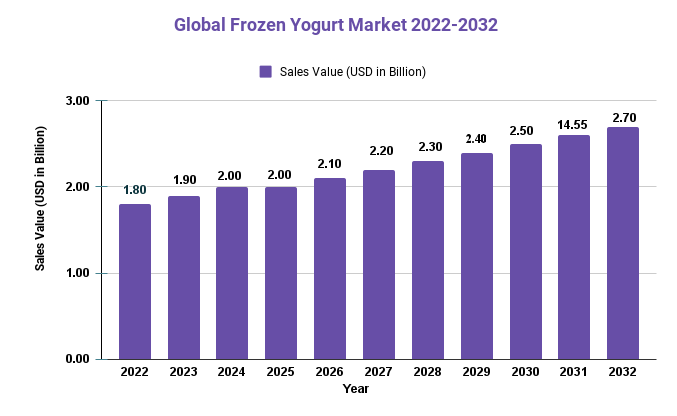Global Frozen Yogurt Market Is Encouraged to Reach USD 2.7 Billion in 2032 at a CAGR of 4.1% | Market.us

Page Contents
Market Overview
Published Via 11Press : Frozen yogurt market, also known as froyo, is a popular dessert choice for many people. It is made from yogurt that has been frozen and mixed with various toppings like fruits, nuts, or candy. The frozen yogurt market has seen significant growth over the years due to its health benefits compared to other desserts like ice cream.
In addition to being low in fat, frozen yogurt contains probiotics that promote gut health and boost immunity. Another reason why frozen yogurt has gained popularity is that it offers a wide variety of flavors that cater to different dietary needs as well as personal preferences. Some froyo shops even offer dairy-free and vegan options for those who are lactose intolerant or follow a plant-based diet.
The Global Frozen yogurt Market size is expected to be worth around USD 1.8 Billion by 2022 from USD 2.7 Billion in 2032, growing at a CAGR of 4.1% during the forecast period from 2022 to 2032.
While it may seem simple enough to make at home with just a few ingredients, getting the perfect texture and taste can be achieved by following some basic tips such as using high-quality ingredients and ensuring the right balance of sweetness and tanginess in the mixture. With so many options available both at home and out in the market, it's no wonder why frozen yogurt continues to be a favorite dessert among people of all ages.

Request For Sample Report Here: https://market.us/report/frozen-yogurt-market/request-sample/
Regional Snapshot
- North America: Over 2021-2026, frozen yogurt market growth is forecast at 6.1% compound annual compound. North America's most lucrative market lies within its borders: in particular, the US is notable for having high demand for non-fat or low-fat frozen yogurt products.
- Europe: Over the forecast period, frozen yogurt sales in Europe are anticipated to experience substantial expansion. Europe-wide, major frozen yogurt markets include Britain, France, and Germany with these areas boasting health-minded consumers preferring low or nonfat frozen yogurt products.
- Asia Pacific: Analysts expect the frozen yogurt market in Asia Pacific will experience the fastest compound annual, compound average growth over its projected period, at 7.2% compound annual compound average compound annual compound growth during its forecasted period. Main markets include Japan, China, and South Korea where this trend can be found due to changing consumer preferences as well as an increasing disposable income level.
- Middle East-Africa: frozen yogurt industry expansion forecast. Main markets include Saudi Arabia, South Africa and the United Arab Emirates fueled by increasing health awareness and disposable income growth.
- Latin America: Frozen yogurt consumption in Latin America has experienced modest growth over recent years. Brazil, Mexico and Argentina are major frozen yogurt markets within this region and this region's frozen yogurt sales continue to expand due to increasing interest for non-fat/low-fat frozen yogurt as well as increased health awareness.
Drivers
- Health awareness: Frozen yogurt has long been recognized as a healthier alternative to ice cream due to its lower fat content and nutritional benefits, prompting increased demand from consumers who prioritize healthy eating habits. The growing awareness surrounding frozen yogurt consumption continues to boost sales worldwide.
- Variety of Flavors and Additives: One key driver of the frozen yogurt industry is its variety of flavors, toppings and add-ins available to consumers allowing them to customize their frozen yogurt according to individual taste – something which draws customers in even further!
- Rising disposable Income: Rising disposable income among consumers is another driving factor of the frozen yogurt market. When consumers have more discretionary spending power, they're more likely to purchase premium frozen yogurt products.
- Convenience and Accessibility: Frozen yogurt products' ease of access through both retail and foodservice channels is also contributing to their rise. With products being readily available across different retail formats such as supermarkets, hypermarkets and convenience stores for purchase by consumers makes the market that much stronger.
Restraints
- Frozen yogurt market growth could be hindered by competition from other frozen desserts like ice cream and gelato, which could pose as threats.
- Price Sensitivity: Frozen yogurt market challenges may stem from consumers being price sensitive when considering purchasing these products; their higher premium pricing could dissuade some individuals from making purchase.
- Seasonal Demand: Frozen yogurt consumption tends to peak during the warmer summer months, restricting market expansion in regions with shorter summer seasons.
- Health Concerns: While frozen yogurt may seem healthier than its dairy-based counterpart, consumers who prioritize health can still have reservations regarding sugar and calorie levels present in frozen yogurt products; this could limit growth within consumers who prioritize this aspect of nutrition.
Make an inquiry before picking up this report @ https://market.us/report/frozen-yogurt-market/#inquiry
Opportunities
- Increased Demand for Plant-based Frozen Yogur: As plant-based products become more and more mainstream, their increased popularity provides frozen yogurt manufacturers an opportunity. Consumers seeking plant-based alternatives to dairy-based dairy products has spurred an explosion in interest for plant-based frozen yogurt options – thus driving demand.
- Innovation in Flavors and Packaging: Companies can use innovation in flavors and packaging to differentiate themselves in the market and attract more consumers. Offering new or unique flavors can set them apart in what can otherwise be an oversaturated marketplace.
- Expand into New Markets: The frozen yogurt market presents companies with an opportunity to expand into emerging markets like Asia Pacific and Latin America, where consumer desire for healthier alternatives combined with rising disposable income is propelling market expansion.
- Collaboration With Other Industries: Partnering with health and wellness brands provides frozen yogurt markets an opportunity. Collaboration can help companies promote the health benefits of frozen yogurt to health-minded consumers and draw in additional sales.
Challenges
- Tight Competition: The frozen yogurt market faces immense competition from both other frozen desserts as well as healthy snack alternatives, making it hard for companies to differentiate themselves in the marketplace and attract customers.
- Supply chain challenges: The frozen yogurt market presents unique supply chain issues, from procuring quality ingredients and maintaining their integrity during transportation and storage to meeting strict quality control measures during product distribution and consumption.
- Health concerns: Although frozen yogurt may seem healthier than its dairy-based counterpart, some consumers may still express reservations over its sugar and caloric content; this could limit market growth among individuals who take health seriously.
- Economic Instability: Economic instability and fluctuations of exchange rates may impact the frozen yogurt market negatively, leading to consumers cutting spending on premium items during times of uncertainty; which in turn lowers demand for frozen yogurt products.
Key Market Players
- Yogen Fruz
- Menchie’s
- Pinkberry
- Red Mango
- TCBY
- Yogurtland
- llaollao
- Perfectime
- Ben & Jerry’s
- Micat
- Orange Leaf
- Yogiboost
Key Market Segments
Type
- Plain Frozen Yogurt
- Flavored Frozen Yogurt
Application
- Minor (age<18)
- Young Man (18-30)
- Young Woman (18-30)
- Middle-Aged Person (30-50)
- Senior (age>50)
Top Impacting Factors
- Technology advancements: The market for automotive instrument clusters is propelled forward by advances in technology such as digital instrument clusters and displays with augmented reality displays, both of which improve user experiences while increasing the functionality of instrument clusters. As these advances increase market growth exponentially.
- Demand for electric vehicles continues to surge: this trend drives automotive instrument cluster sales for these cars. Instrument clusters must display battery information, charge status updates, and driving range maps in their displays for electric vehicle users.
- Demand for autonomous and connected vehicles: Autonomous and connected vehicle demand has driven the growth of automotive instrument cluster markets; instrument clusters must display information in real-time while also seamlessly integrating with navigation and infotainment systems for these cars.
- Regs & Compliances: Automotive industry faces stringent regulatory requirements and issues of compliance related to safety and emission issues, in particular. Instrument clusters equipped with advanced technology that displays relevant information can assist drivers in meeting regulations and requirements is one of the keys drivers need in complying with them.
- Consumer Demand for New Features and Technology: Automotive instrument cluster manufacturers have become more aggressive at meeting customers' desires for advanced features in their cars, like digital instrument clusters. Manufacturers aim to meet this increasing consumer demand while distinguishing themselves from their competition and establishing themselves as market leaders in this space.
- Raw Materials and Component Availability: One key aspect that impacts instrument cluster production is the availability of components and raw materials required for its creation. Any interruptions or shortages in supply chains could halt their production altogether.
Recent Developments
- Danone is undertaking a review of their yogurt classification; with new ideas to contribute.
- Ben and Jerry's Launch New Line of Greek Yogurt Products
- First frozen yogurt brand to offer special discounted pricing to veterans and active military personnel.
- Administration Broomfield (Restaurant News Release). TCBY.
Report Scope
| Report Attribute | Details |
| The market size value in 2022 | USD 1.8 Bn |
| Revenue Forecast by 2032 | USD 2.7 Bn |
| Growth Rate | CAGR Of 4.1% |
| Regions Covered | North America, Europe, Asia Pacific, Latin America, and Middle East & Africa, and Rest of the World |
| Historical Years | 2017-2022 |
| Base Year | 2022 |
| Estimated Year | 2023 |
| Short-Term Projection Year | 2028 |
| Long-Term Projected Year | 2032 |
Frequently Asked Questions
Q: What is the current size of the Frozen Yogurt Market?
A: The Global Frozen Yogurt Market size is USD 1.8 Billion in 2022.
Q: What is the projected growth rate for the Frozen Yogurt Market?
A: The Frozen Yogurt Market is expected to grow at a CAGR of 4.1% from 2023 to 2032.
Q: What are some of the key players in the Frozen Yogurt Market?
A: Some of the key players in the Frozen Yogurt market include Yogen Fruz, Menchie’s, Pinkberry, Red Mango, TCBY, Yogurtland, llaollao, Perfectime, Ben & Jerry’s, Micat, Orange Leaf, Yogiboost.
Contact:
Global Business Development Team – Market.us
Market.us (Powered by Prudour Pvt. Ltd.)
Send Email: [email protected]
Address: 420 Lexington Avenue, Suite 300 New York City, NY 10170, United States
Tel: +1 718 618 4351
Website: https://market.us
Content has been published via 11press. for more details please contact at [email protected]
The team behind market.us, marketresearch.biz, market.biz and more. Our purpose is to keep our customers ahead of the game with regard to the markets. They may fluctuate up or down, but we will help you to stay ahead of the curve in these market fluctuations. Our consistent growth and ability to deliver in-depth analyses and market insight has engaged genuine market players. They have faith in us to offer the data and information they require to make balanced and decisive marketing decisions.



